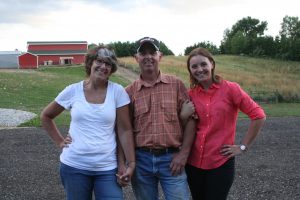Scott and Peg SchultzOnsted, MI
 Scott and Peg Schultz
Scott and Peg Schultz
Lenawee County, Michigan
Fifth generation farmer Scott Schultz owns and operates Green Hills Farms, established in 1904, with his wife Peg. Currently, Scott rotates about 200 acres of row crops and Peg farms cage-free and free-range eggs. The family also has a hoop house where they grow radishes; red and yellow beets; a variety of greens (including kale, spinach, mesclun, and chard); white and sweet potatoes; a variety of hot peppers, sweet peppers, tomatoes, and beans; edamame; brussels sprout; cabbage; onions; carrots; eggplant; and a collection of herbs (including rosemary, thyme, oregano, basil, mint, and chamomile).
“The farm was in the Conservation Reserve Program up until four years ago when I decided to start farming it,” Scott said. “Having the ground in (CRP) was basically having 12 years of cover crop, so the ground was in really good condition and we wanted to keep it that way.”
About 65 percent of the Schultz farm is in minimum till and the rest is in no-till. This was the first year Scott used “true” no-till and the first full year of using cover crops. “We planted a cover crop into our corn last summer with an airplane and let it go through the winter. Then it started growing again in the spring and we had cereal rye between knee and waist high when I planted my soybeans right into it.”
Scott says NRCS helped him put together a no-till and cover crop program (and recommended using cereal rye), but was hooked on experimenting with covers after attending a National No-Tillage conference last year. “There are so many people out there doing the right thing,” he said of the meeting. “That’s why I went there – to make friends and get knowledge. There were people there that have been no-tilling for 30, 40 years. I would like to be that guy someday – to help someone else” by sharing my experience using conservation practices.
One of the biggest challenges for Scott and Peg is highly erodible soils. “It’s hilly (here),” Scott said, “so the purpose (of using the cover crops) was to hold the top soil in place – to basically eliminate erosion and give us the ability to capture nutrients that were left over from the last crop. That rye grass will hold that nutrient there. So when we terminate the rye grass, that nutrient is given back to the new crop.”
“It’s worked quite well,” he added. “We had a little bit of equipment trouble the way I had things set up with that tall grass, but it didn’t take much to remedy that and we were on our way.”
The Schultz family also raises hogs to finish and has been selling the pork directly to customers. One of the selling points of the Schultz’ hog operation is their farm’s meat, cropping systems, livestock systems, and homestead system verifications. Earning certifications for conservation and sustainability practices “is a great thing to do,” Scott said. “I think it’s the right thing to do. It tells people that we’re maintaining a sustainable environment around our farm. Most of the people we sell pork comment on that.”
The Benefits
After just a year of using cover crops, Scott says he’s “saved on herbicide for sure.”
“I had test strips basically around the edge of the field because the airplanes have a hard time seeding right to the edge,” he said. “Where they couldn’t get the cover crop on, we had weeds.” Covers have also boosted the amount of micronutrients in his soil. Where he planted rye cover, Scott said he found eight to ten inches of solid root structure jam packed full of earth worms. “Right next to it where there wasn’t any cereal rye, I had weeds all over, and when I dug the pit, there were no worms at all.”
“That’s one of the things that I’m really excited about. All those micronutrients are going to be where those worms are – helping to build my soil biology.”

